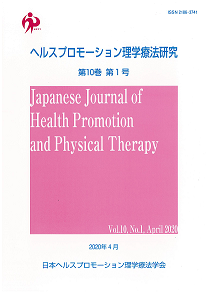Volume 10, Issue 1
Displaying 1-7 of 7 articles from this issue
- |<
- <
- 1
- >
- >|
ORIGINAL ARTICLES
-
Article type: original article
2020Volume 10Issue 1 Pages 1-8
Published: April 30, 2020
Released on J-STAGE: May 22, 2020
Download PDF (320K) -
Article type: original article
2020Volume 10Issue 1 Pages 9-13
Published: April 30, 2020
Released on J-STAGE: May 22, 2020
Download PDF (349K) -
Article type: original article
2020Volume 10Issue 1 Pages 15-20
Published: April 30, 2020
Released on J-STAGE: May 22, 2020
Download PDF (605K) -
Article type: original article
2020Volume 10Issue 1 Pages 21-25
Published: April 30, 2020
Released on J-STAGE: May 22, 2020
Download PDF (300K) -
The Relationship Between Levels of Care and Physical Functioning in Community-Dwelling Elderly WomenArticle type: original article
2020Volume 10Issue 1 Pages 27-31
Published: April 30, 2020
Released on J-STAGE: May 22, 2020
Download PDF (272K) -
Article type: original article
2020Volume 10Issue 1 Pages 33-39
Published: April 30, 2020
Released on J-STAGE: May 22, 2020
Download PDF (403K)
SHORT REPORT
-
Article type: short report
2020Volume 10Issue 1 Pages 41-44
Published: April 30, 2020
Released on J-STAGE: May 22, 2020
Download PDF (247K)
- |<
- <
- 1
- >
- >|
